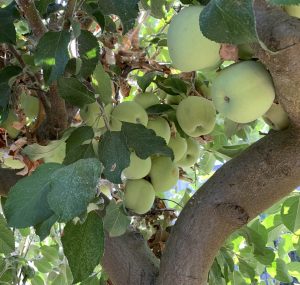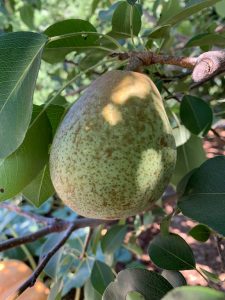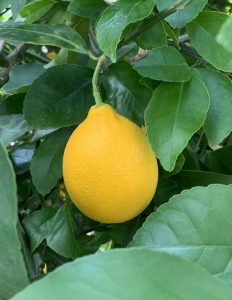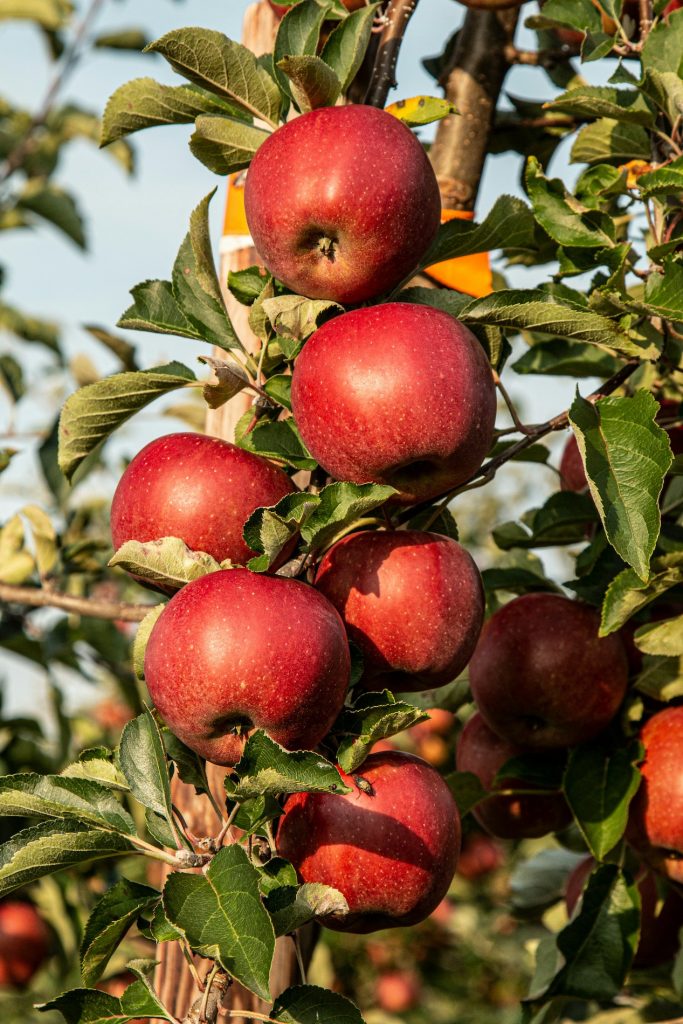Many people have a lemon tree or a similar citrus tree in their backyard. Maybe it is in the corner of the yard and is neglected until it needs pruning or harvesting. Or maybe it is a prominent evergreen tree taking center stage. Once a year, the fruit falls on the ground, and it becomes a nuisance. Because, after all, you only use a few lemons. Even lemon meringue pie only uses a few lemons.
Did you know growing various fruit trees in your backyard is possible? Yes, you can do it. You can grow many types of fruits. All you need is more than four trees to have an orchard. You can get trees on semi-dwarf or dwarf stock. That means the trees will not get gigantic, and you can fit them in your backyard.
Growing Fruit Trees in Your Backyard
Furthermore, you can prune them to size, keeping them a controlled seven or eight feet tall if you would like. You can even keep them smaller than that. The great thing about fruit trees is that they give you fruit year after year, potentially for decades.
There’s something deeply satisfying about tending to an orchard. Perhaps it’s the promise of juicy, sun-ripened fruit dangling from branches, or the joy of witnessing nature’s bounty unfold in your backyard. Whatever the reason, growing them is an immensely rewarding endeavor that offers not just delicious harvests but also a connection to the rhythms of the seasons and the beauty of the natural world.
Fruit trees hold a special place in many gardens, providing food, shade, beauty, and a habitat for birds and other wildlife. Whether you’re an experienced gardener or a novice with a green thumb, there’s a tree suited to your space and climate.
Before you start planting, it’s essential to consider which trees will thrive in your area. Different varieties flourish in different climates and soil conditions, so do your research or consult with local gardening experts to select trees that are well-suited to your region.
Growing an orchard requires patience and dedication, but the rewards are well worth the effort. There’s nothing quite like biting into a sun-warmed apple or picking a basket of ripe peaches from your own backyard. Beyond the delicious harvests, orchards enrich our lives in countless ways, connecting us to the earth and the cycles of nature.
Growing Requirements
There are a few requirements to have fruit trees in your backyard. Number one, they do need an adequate amount of sun. At least six to eight hours is preferable. It is also advised to check your garden zone in order to determine the types you can plant in your backyard. There are many varieties, as well as those that are grafted onto a rootstock that favors certain types of conditions. For example, if you have consistently wet areas, you may want to try a rootstock that handles saturated soil well.
Many trees also require what is called chill hours, which is a need to get a certain number of hours below 45 degrees Fahrenheit (ca. 7 °C) for them to appropriately enter dormancy for the winter. If they do not get enough chill hours, they will not become dormant and will not produce fruit. Of course, I am talking about traditional fruit trees here, not things like avocados, guavas, etc. There are more and more varieties of trees that are coming out and have very low chill requirements.
To plant, it is not necessary to dig a large hole or to fertilize when planting. If your tree is in a pot, dig a hole about as deep as the pot and twice as wide. Plant your tree in your soil, making sure not to bury it too deep. It should be planted at the same depth as it is in the pot. If planting a bare root tree, dig deep enough to bury the tree just above the roots and well below the graft union.
Make sure the hole is plenty wide and spread the roots outward. Bury it with native soil. I staked all my trees for the first year to prevent wind damage. Planting time is a good time to put a stake in it.
Fruit trees do require maintenance. First, they should be pruned every year, at least during the dormant season, to adjust the shape and structure of the tree and to remove damaged or diseased limbs. By pruning properly, you will also improve airflow through your tree and make harvesting easier. In addition to dormant season pruning, you may find it worthwhile to summer prune your trees to control their size. It is wise to invest in a sharp pair of pruners, loppers, and a folding pruning saw. Research proper pruning techniques in books or online before your first pruning.
There are too many types of fruit to cover in this blog, but I will briefly discuss a few popular ones. For more information about fruit trees, please see my book Backyard Big: Growing Food in Your Backyard. See the book page on my website for links to purchase autographed copies and more. I am posting more and more content about fruit trees in my garden blog as well.
Apples

Apples have some chill hour requirements; however, they are one of the easiest trees to grow as they can do well in almost any soil type. Apple trees survive very low temperatures, high winds, and just about anything nature will throw at them.
Fertile, well-drained soil is preferred by apple trees, but some rootstocks can be used to deal with saturated soil if this is a problem. There are many self-fertile apple trees, although it is generally recommended to have at least two apple trees that will pollinate each other to ensure a good harvest.
There are two basic types of apples: spur-type and non-spur. Spur-types grow differently than the normal fruit tree. They have fewer limbs and have these short, stubby, wrinkled stems on their branches.
Spur-types will produce more apples and need less pruning. It is possible to head back branches to produce more spurs and, thus, fruit. Non-spur types lack those wrinkled stems and can handle heavy pruning like normal. It is useful to know which type of tree you have so that you can prune it correctly.
Pears

Pears are good for you. They are known to boost heart health, are anti-inflammatory, and promote good gut health, among other things. Compared to apples, pears are still second best, and far more apples are consumed than pears. Pears are separated into two types: European and Asian.
The European pear is the one that we are most familiar with. These are picked before they are ripe and continue to ripen off the tree, making them of great commercial use. Asian pears are shaped more like an apple and are picked when they are ripe. They also have thick skin.
All pears will tolerate non-ideal soil conditions. They do well in moist, cloudy weather. A good, thick mulch layer is always recommended for pears. They will grow rapidly, and fertilizing them is not necessary. European pears take four to six years to start to bear fruit, while Asian pears take two to three years to bear fruit.
Pruning is similar to apple trees and depends on choice. You can prune with a central leader for a few years and then cut it back or prune out the central leader early for a bush type of plant. Pears tend to grow very upright, and you may find it necessary to spread branches or weigh them down to increase the angle and spread of branches. You will also likely need to thin your pears to get full-sized fruit.
Peaches and Nectarines

Peaches and nectarines don’t store well, and so, of course, the ones you get in the stores usually taste terrible. Unless, for some miraculous reason, the stores get them ripe from orchards nearby during harvest season. Otherwise, they’re just disgusting, and I never even buy them at stores.
When they’re growing on your trees, you can time the ripeness to perfection. There’s nothing like a perfect peach or nectarine. To me, the trees are vigorous and sort of demanding. There’s the peach leaf curl thing and the continual pruning.
Heavy pruning and pretty good pest pressure make these pretty tough to handle but worth every bit. They do have some chill requirements, which are usually a little higher than other fruit trees. It’s all worth it, as fresh peaches and nectarines are just fantastic. This fruit is usually so tasty that I don’t even need to cook it or do anything. I just eat them fresh, like candy. Some years, when we have an abundance, peach cobbler or nectarine fruit salad is made.
Peaches and nectarines grow just fine in ordinary garden soil; however, these plants like dry, sandy soils. Heavy, wet soils are not preferred. Of course, the type of rootstock will determine the final soil preferences. These trees do grow quickly and, in most cases, do not need fertilizer.
Have patience that first year. Once established, they will produce lots and lots of fruit. Peaches and nectarines are not as long-lived as some other fruit trees, such as cherries and apples. Approximately 10 years is the lifespan of these trees.
Citrus

Who doesn’t have a lemon tree in their backyard? Citrus trees are a beautiful part of the backyard as they are always bright green and productive plants, bearing fruit several months of the year. One does not need to live in a region with chill hours for citrus, and, in fact, citrus will have problems with temperatures too far below freezing. Aside from their ornamental benefits, they offer an exceptional source of vitamin C, fiber, and folic acid.
Common citrus grown in backyards today include orange, lemon, lime, grapefruit, kumquat, and tangerine citrus. Trees are very popular in subtropical and tropical areas. Plenty of citrus also grows in Mediterranean lake climates, where temperatures will get as low as the 20s during the winter months.
Citrus comes in standard or dwarf sizes. Dwarfs do well in containers, and standard-sized trees can reach 30 feet if uncontrolled. If they are kept small, they can be protected with frost blankets as needed. They need full sun and like water one to two times a week.
Typically, twice a week when they’re young and once a week when they are older. Citrus trees need fast-draining soil, as overwatering can harm these trees. They are self-fertile, often drawing significant numbers of bees at the flowering stage. Pruning should be done in the spring after the danger of frost has passed. You can prune them for shape, although it’s not required for fruit. Citruses are usually grafted on top of vigorous rootstock. Make sure to remove sprouts coming from the trunk, particularly those that leave the trunk below the graft.

